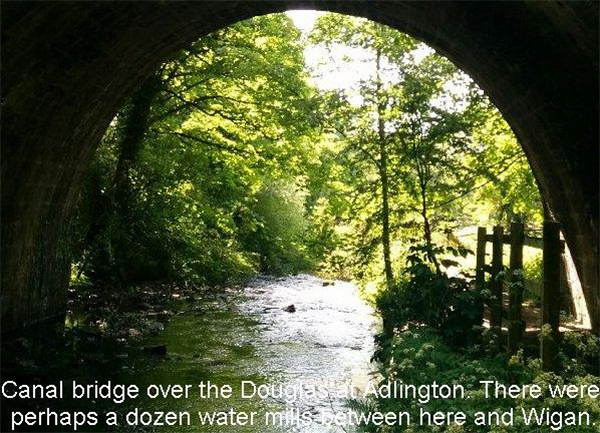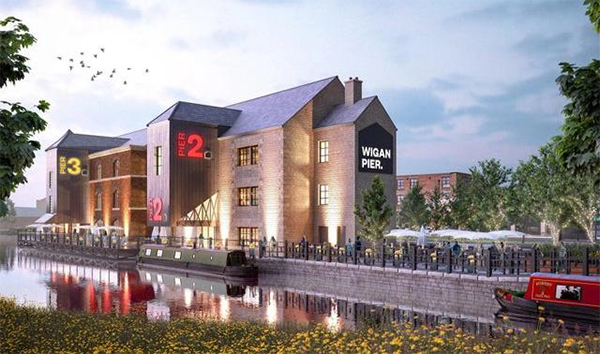
This could be the title of a new project we're starting which will help keep us going through lockdown. It has been suggested before but, because it will be mainly desk based, it seems to be something we can do without the risks involved in fieldwork activity. The idea is to research and record as many historical and archaeological features as we can on or around the Douglas valley. Initially we're thinking from the river's source on Winter Hill through Horwich, Adlington, Arley and into Wigan. However, with enough resources, we will be able extend our study all the way to the Ribble estuary. We will be covering all periods but most of it, we imagine, will be industrial (i.e. post-Medieval). The project will draw on existing work done by the Society and others. For example in the mid 1990s we carried out studies of 2 water mills in the Arley Valley and, not far way, possible Roman coal mining. The section from Wigan down stream has had particular attention in the past being, as it was in the mid 18th century, converted into the Douglas Navigation. This allowed boats to travel from Wigan to the Ribble estuary and back. This was before the canal was built later that century (Mike Clarke and Bill Froggatt of the Canal & River Trust have described in some detail how this was achieved). Also a few years ago, Derek Winstanley wrote a paper (with our help) about Wigan Pier and Dock (an abridged version appeared in the 2016 Autumn edition of the Past Forward Magazine P22). We also got involved in a project in 2017 looking for a possible surviving river lock at Appley Bridge (Newsletter No.206).
Our project goal will be to produce a report (with a gazetteer attached perhaps) and a presentation. The research will mainly revolve around the use of map regression and information available online (essential visits to the archives will be added at a later date when this becomes possible). Some site visits will be required for photographic reasons but would only involve 2 or 3 persons to keep risks to a minimum. If you want to get involved let me know (with an idea of the area you would be interested in).
Wigan Pier Development

Speaking of the Pier, the area has changed dramatically over the years particularly with the building of the Southgate bypass. But now a brave new regeneration plan has been approved costing over £1m. Work is already underway, but this isn't the first time this iconic Wigan landmark has been given a makeover. In the mid 1980s, after many years of dereliction, the empty warehouses became the Way We Were Museum and the Orwell Public House (there was even an Education Centre and Night Club). At its peak in the mid 1990s, the award winning complex had attracted over 10 million visitors. By the turn of the century, however, its popularity had waned and the Museum and Centre went into decline eventually closing in 2007. The Wigan Pier Nightclub similarly in the 1990s had great fame and popularity as a rave venue, but latterly became derelict and was eventually pulled down in 2014. A new chapter is now unfolding with this new regeneration scheme which boasts to transform the neglected asset into a vibrant cultural and residential centre. This is to including a wedding venue, gin-distillery, micro-brewery, food hall and waterside town houses - something perhaps for everybody (lets hope it can live up to expectations). There's more information on the Wigan Today website here.
Bradshaigh's Observatory
This is not wholly unconnected, as Sir Roger Bradshaigh of Haigh Hall was one of the original applicants to Parliament for the Douglas Navigation's construction of in the early 1700s. Anyway a study of the enigmatic buildings, which once stood on the hill to the east of the Hall, has been made (again with our help) by Karen Lynch who runs a website called The Folly Flâneuse. On it she describes the buildings as follies in the form of sham ruins. Confusingly though a summer house, made of cannel coal of all things, also seems to have existed there at the same time (we searched for any evidence of these buildings in 2016 but even the GPR equipment failed to detect anything).
Wigan History Podcast
The latest episode of Tom Marriot's podcast is now available for your entertainment during lockdown. This one is about the Iron Age and the Celts (not a great deal about Wigan to be honest but he does tell the fascinating story of Cartemandua of the Brigantes and joins in the speculation on the location of the lost sea port of the Setantii. wiganhistorypodcast.co.uk. Keep safe - BA
|



